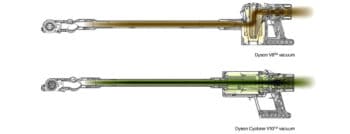If you are looking for a new vacuum and you want to go cordless then you need something with the power and versatility to replace a full-on canister vacuum. A smaller Dyson, like the V6 cordless or V7 cordless, will work if you have no rugs and a reasonably clean home, but bigger messes require bigger fixes.
In this article we’ll compare Dyson’s full-power cordless vacuums: the Dyson Cyclone V10 and the Cyclone V11. Since “Cyclone” sounds cool but means nothing, this is the last time we’ll use that particular bit of branding.
The Basics
The Dyson V10 and V11 are both full-power cordless vacuums that are meant to replace a drag-behind, canister-style vacuum that plugs into the wall. It’s no easy task to replace the size of a canister with the power of a wall outlet, with something you carry with you and power with a battery!
The Dyson V10 is the older model, having been released in March 2018. The V10 came soon after the release of Dyson’s V7 but was actually a replacement for the older V8. The V10 was, and still is, a high-power vacuum with a larger capacity and heavier body than the standard cordless Dysons (like the V7).
The Dyson V11 is newer, arriving in March 2019. The V11 wasn’t necessarily a replacement for the V10 (which is still available), it simply was described as an upgrade to the V10 with a number of more advanced — but unnecessary — features. These features include more power, better battery life, and an LCD screen.
The V10 has an original price of $599 (depending on the model) while the V11 originally started at $699.
Dyson V10 vs. V11 Current Pricing
Pricing will vary considerably based on the model you get but here are the best street prices at the moment:
Prices have dropped considerably since each vacuum launched, specially after Black Friday 2019 and the passing of the holiday season, where Dyson is known for price cuts. The Dyson V10 is currently regularly available for under $400.
Models
Dyson V10 Models
- V10 Absolute
- The V10 with all the accessories, including the Soft Roller Cleaning Head (the Fluffy head)
- MSRP (at launch): $600
- V10 Animal
- The V10 without the Soft Roller Cleaning Head
- MSRP (at launch): $550
- V10 Motorhead
- The Torque Drive head gets downgraded to the older design, the Direct Drive Head
- Few accesories
- MSRP (at launch): $500
Dyson V11 Models
- V11 Torque Drive
- LCD screen displays remaining battery life and switches power modes
- MSRP: $700
- V11 Animal
- All the V11 features except the LCD
- MSRP: $600

Design Features
The Dyson V10 was the company’s first handheld vacuum to use a straight-through design, which has more direct and efficient airflow than the Dyson V8, V7, V6, DC59, and older designs. The downside of this design is that it meant for a much longer vacuum. The V10 was also much heavier than previous designs. This wasn’t a result of the direct airflow design, but it was a notable change. The V11 continues with the direct design.
LCD Screen
The LCD screen remains the defining feature of the V11, but you have to keep in mind that is only exists on the Torque Drive model! The LCD will cost you $100 extra, over the not-exactly-cheap V11 Animal and it has pretty limited functionality. It will tell you your remaining battery life (in minutes), how charged your battery is, and what vacuum mode you are using (Auto, Boost, or Eco).
The LCD screen will also alert you of potential clogs or losses of suction power.
Suction Power
The V11 was upgraded significantly to have more power than Dyson’s previous cordless vacuums and as much power as a plugged-in corded vacuum.
Battery Life
The V10 has three operating modes: Low, Medium, and High (Dyson calls them Boost and Turbo and things like that, but don’t let them confuse you!). The V11 also has the
The Dyson V10 has up to 60 minutes of vacuuming power then using the Direct Drive Head (only sold on the Motorhead model), but this is the worst cleaning head Dyson sells! The V10 has 35 minutes of battery life when using the newer Torque Drive Cleaner Head (in Low mode) but up to 40 minutes when using the Soft Roller Cleaner Head (only included on the Absolute).
Then using Medium mode and then Torque Drive head expect battery life to be about 25 minutes and for the battery life to be about 5 minutes when on High. High is only designed for spot cleaning so this isn’t a huge problem, but 5 minutes is still a very short amount of time.
The Dyson V11 has 60 minutes of battery life on Eco mode (aka Low) when using its standard Torque Drive head. Battery life will vary with Auto, as it’s automatically supposed to change based on your home’s conditions. Expect around 30 minutes for a sort-of-dirty home. On Boost mode (aka maximum power) total run time should be a bit under 10 minutes.
Charging Time
- Dyson V10: 3.75 hours
- Dyson V11: 4.5 hours
Which To Buy?
The Dyson V10 and V11 are very similar devices, and while the V11 wins out in the cool factor (by a wide margin), the V10 seems to be the vacuum to get given the generous price drops that 2020 has brought to the V10.
